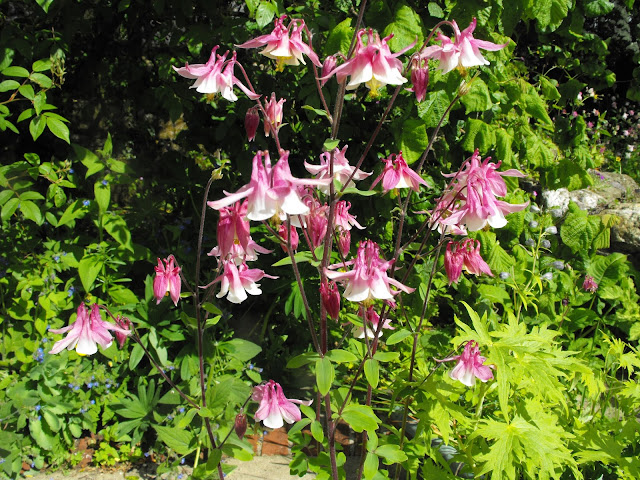Friday, 29 May 2015
Aquilegias
In recent winters, I have lost some of my more unusual colours, and even managed to lose the nearly black Nora Barlows last winter. The commonest colours are the toughest, it would seem. This pretty pink and white one lives in a big pot and has survived to bring me pleasure yet again.
The very dark ones seem to be concentrated in the Yard, so I must sprinkle some of their seeds up in the pale pink area this year.
There used to be a lot of William Guinness here, but now there's just one on the right (dark with a white centre).
I have a few of the very pure white ones, which start off a yellowy limey colour, as seen between my fingers.
The palest of pinks with a lilac back to it. I have plenty of these.
Tousled Norah Barlow-ish.
Some simple blue-purple ones here in the stoney garden.
They seed themselves everywhere, including in tiny cracks in concrete paths, where I haven't the heart to yank them out . . .
I love these deeper colours.
Almost black - sorry for the blurry look of out-of-focus camera.
Equally blurry lighter purple William Guinness.
Above and below, these are from around the patio down in what was my mum's garden. Below: showing that you can get variations of flower on the same plant.
Finally, the last surviving one of my more exotic sorts - this is yellow. It's in a big pot and they seem to do better that way. A lot of the little pots which lost their occupant over the winter had small white grubs in and I think these had been eating the plant roots.
Sorry for a none-too-coherant posting but I feel brain-dead this morning and just want to go back to bed, to be honest! I'll try and update this later.
Subscribe to:
Post Comments (Atom)














I had managed to establish one small clump of these in the now buried garden in Gradyville. I had a few more exotic ones in my Wyoming garden. I didn't realize they would make could subjects for pots. I'm thinking they could be naturalized in the woods beyond the stable--probably coming on with the wild blue phlox and such that bloom there.
ReplyDeleteI just love them, they are such faithful plants, coming back year after year with little or no looking after. The only other plant that does that is cosmos and I remember a garden from many years ago which was just pure cosmos of all colours and nobody ever touched it.
ReplyDeleteMy yellow aquelegia have never flowered - in fact, although I was given yellow seed I have actually no proof that that is what it is, although they come up every year. All my dark blue ones (which used to be the most common) have disappeared. Now I have various shades of pink, deep and pale, often with lemon coloured centres - some double and some single. They are a delight and you look to have some beauties.
They are beautiful colours, and the flowers last a long time. I have most of mine in the garden in clay soil, and I am still digging up loads of new plants.
ReplyDeleteHow lovely they all are! Ours are in flower too. Some will be the children of your aquilegia, from your gifts of seeds and young plants over the years. The deepest, darkest purple one is almost black. It self seeded in the vegetable patch and has been allowed to stay.
ReplyDeleteLove love love the yellow wall with the pant that seeded it self in the crack concrete
ReplyDeleteIt is the perfect color for that wall.
cheers, parsnip
I agree with your love of dark colored blossoms; they are my favorite too.
ReplyDeleteI love aquilegias and let them seed more or less as they like. They seem to be doing especially well this year and my garden is awash with them. You're right though that the ordinary dark blue/purple ones are the most numerous. Hope you've perked up again since you posted.
ReplyDeleteI absolutely love aquilegias and of course I can't even think of growing them here in my tropical climate - so I shall have to come back to admire your photos frequently. We always want to grow the plants which will not thrive in our local climate - human nature I suppose! Cheers
ReplyDeletePS....I showed your flower images to my wife, the head gardener. Those white grubs are the larvae of the Vine Weevil....a real pest.
ReplyDeleteI have written a couple of times today but I am not familiar with making comments on blogs, sorry. I was helping with some research online this morning. The young lady wanted detail on a part of Sholing. I told her of the times I scrumped apples in that valley between Butts Rd and Kathleen Rd. Going online again to find reference to Burseldon Road/Spring Hill I found you, my fellow apple thief. I lived in Butts Rd, on the corner of Canterbury Avenue from 1946 to 1967. We spent every summer over the valley, I have found memories of my home "village" of Sholing. Yours, a fellow Spike Islander, Rod Andrews.... apologies if you have already received a variation of this message.
ReplyDelete